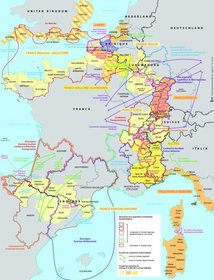Cross-border governance
In the cross-border context, given that it is impossible to have a government as such, it is essential to talk of governance – i.e. a framework that enables diverse public and private players to cooperate across borders.
Focusing on cross-border governance means looking at the issues of ensuring the lasting nature of projects, structuring one-off actions within a longer-term relationship and putting in place an integrated strategy (or common action plan) for a given cross-border territory.
An analysis of the roles of institutional players involved in cross-border cooperation highlights the diversity and dynamism of their different positions.
First, the differences in the way that political, administrative and legal systems are organised on either side of the respective borders call for the creation of very varied structures of governance (in terms of their composition, functioning, remits, the scale of the territory covered and their legal status).
Second, notably in the case of France, local authorities are increasingly playing a leading role in cooperation at the same time as the State is repositioning its role towards supporting local initiatives (particularly in its areas of competence: health, taxation, energy, security, etc.).
Cross-border governance takes many different, more or less structured forms: cooperation protocols, conventions, agreements, consorcios, LGTC, EGTC, ECG, EEIG, etc., depending on the objectives of the different initiatives, the cultures of public action, the resources mobilised, etc.
Factsheet on "Legal instruments"
All the legal instrument factsheets in the Members' Area
In terms of the different territorial levels, it is possible to identify several main types of structure:
- Local (the Eurodistricts along the French-German border: SaarMoselle, Strasbourg-Ortenau, Regio Pamina, Basel Trinational Eurodistrict, Freiburg Region/Central and Southern Alsace; and the cross-border conurbations: the Lille-Kortrik-Tournai Eurometropolis, Greater Geneva, the Basque Eurocity, etc.)
- Intermediate (Franco-Italian Alps Conference, bilateral cooperation between departments/provinces/counties, etc.)
- Euroregional (Alps-Mediterranean, Pyrenees-Mediterranean, Aquitaine-Euskadi, etc.)
- Along the whole border (Working Community of the Pyrenees)
In the cross-border context, the multi-layered nature of governance is an important issue on account of the differences in organisational structure, the asymmetries in the division of competences and the interdependencies between different sectors. There are many examples of multi-layered governance: the Upper Rhine Trinational Metropolitan Region, the Cross-Border Polycentric Metropolitan Region of the Greater Region, the EGTC of the Lille-Kortrijk-Tournai “Eurométropole”, the LGTC of Greater Geneva, etc.).
Up till now, along France’s borders, the structures of cross-border governance consisted primarily of institutional players on either side of the border. However, the involvement of civil society and private sector players is an important element. In this way, alongside the political pillar, the Trinational Metropolitan Region has an economic pillar (chambers of commerce, chambers of trade, development agencies, clusters, etc.), a scientific pillar (universities, further education institutions, research centres) and a civil society pillar (members of the public interested in cross-border issues, associations, private sector groupings and foundations, and official institutions).


